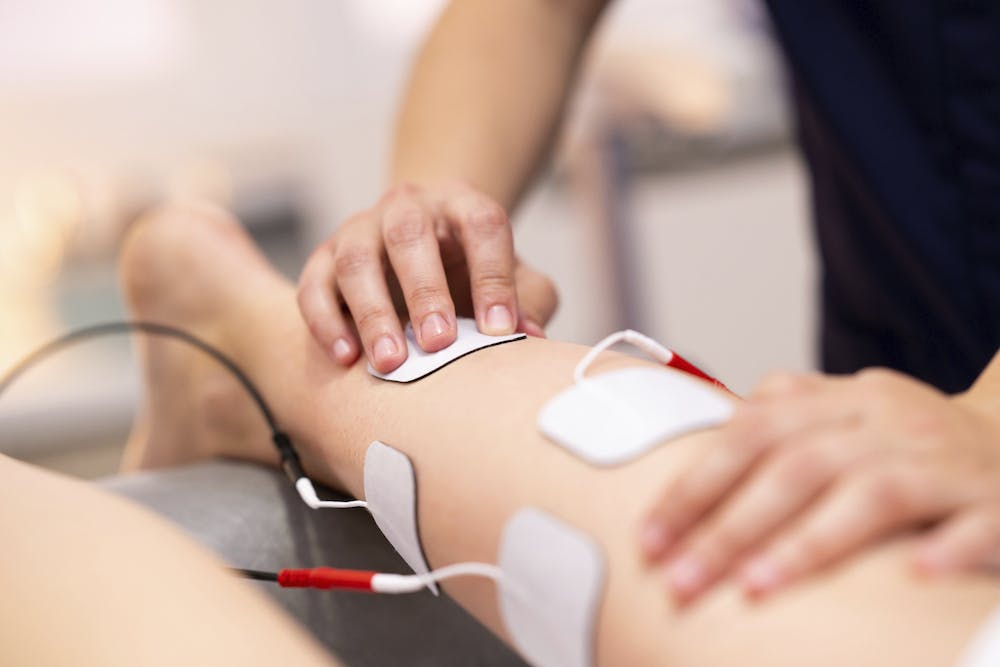-
Heat Therapy
Heat therapy relaxes the muscles and blood vessels, which helps treat muscle spasms and promotes blood flow to the treated area. Heat treatment generally starts in a provider’s office or physiotherapy center several days after the injury when there is less irritation and swelling. It involves the non-pharmacological use of dry or moist heat to the injured area.
There are two main types of heat therapy: dry and moist heat.
- Dry (conducted) heat includes heating pads, heating cushions, or gel packs. Dry heat offers fast heating time, consistent temperatures, ease of use, portability, and convenience.
- Moist (convection) heat treatments can include steamed towels, hot water bottles, hydrocollator packs, hot baths, or moist heating packs. Moist heat penetrates deeper into muscle tissues, achieving a higher increase in blood flow than dry heat. Moist heat also doesn’t dehydrate the skin as dry heat can.
-
Ice
Cryotherapy (also known as “cold therapy” or “ice therapy”) is the use of freezing or near-freezing temperatures to treat acute and subacute injuries and conditions primarily to reduce inflammation. Cryotherapy treatments may involve the use of such tools as ice packs and ice massage alone or in combination with heat (heat pack) treatment, electrical currents and other treatments to reduce pain and inflammation, improve soft tissue healing, increase endurance and improve range of motion (ROM).
Conditions Treated
Common conditions treated by heat therapy and cryotherapy include:
- Acute Localized Edema (swelling)
- Benign Nerve Growths (neuromas)
- Bursitis
- Isolated Nerve Inflammation/ Irritation
- Low Back Pain
- Migraines
- Muscle and Joint Pain and Disorders
- Multiple Sclerosis (MS)
- Myofascial Trigger Points
- Osteoarthritis (OA), Osteoporosis and Rheumatoid Arthritis (RA)
- Pinched nerves (nerve entrapments)
- Recovery from Athletic Conditioning/ Mechanical Skeletal Muscle Stress
- Tendinopathies
-
E-Stim

Microcurrent treatment is the application of electrical stimulation to treat neurogenic pain (caused by nerves), myofascial pain (muscular), and inflammatory conditions.
The body has a continual flow of resonating electrical impulses that transmit signals through living tissues, utilizing electrons, chemicals, and electromagnetic bonds. The body’s tissues are lined with water-hydrated matrices that act as semiconductors to permit the transfer of electrons and communicate specific frequencies. Each cell, tissue, and organ has its own specific frequency that synchronizes its activity within the body. Microcurrent is aligned to support the intricate biological and physiological phenomenon that has been exhibited throughout electrotherapeutics in clinical history – electricity will take path of least resistance as it flows through tissue.
What is a MENS treatment like?
Microcurrent therapy is passive. You sit with the electrodes placed in the appropriate locations as determine by your therapist. Often a coupling agent (water or gel) is used to facilitate the delivery of the MENS.Unlike other forms of electrotherapy (i.e., TENS or NMES), the current is so small that the nerves of the sensory system aren’t stimulated. As a result, there’s no uncomfortable feeling of a shock.
There are often multiple treatment sessions and MENS is typically part of a complete rehabilitation program that involves patient education, exercise, manual therapy, and a home program.
What conditions respond well to microcurrent?
- Neck Pain
- Back Pain
- Arthritis-related Pain
- Radiculopathy (Pinched Nerves)
- Sciatica
- Sprains and Strains


